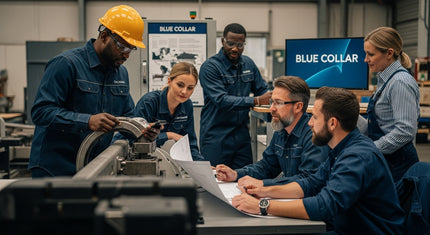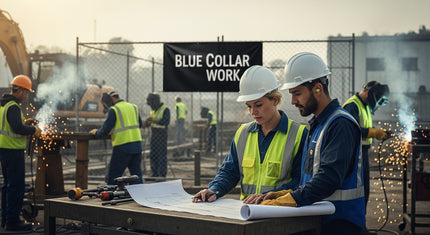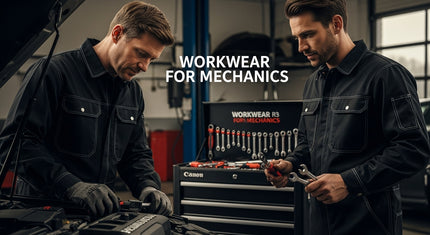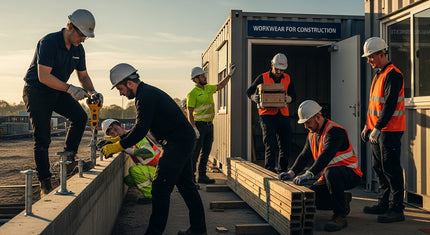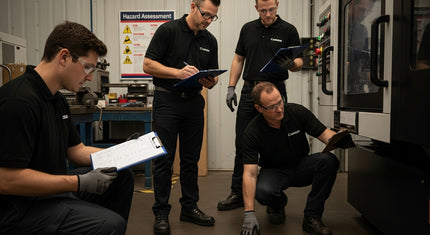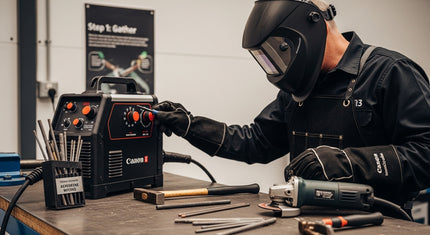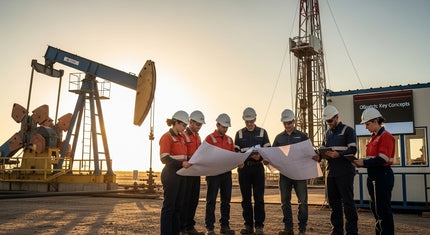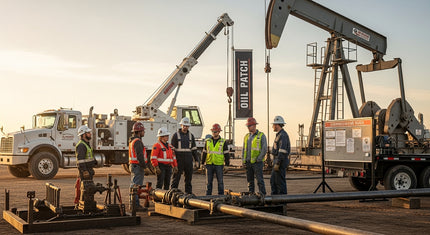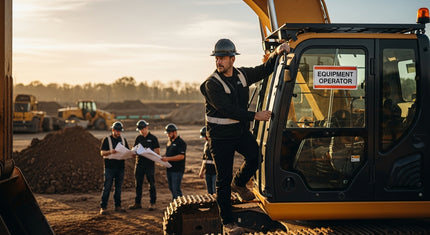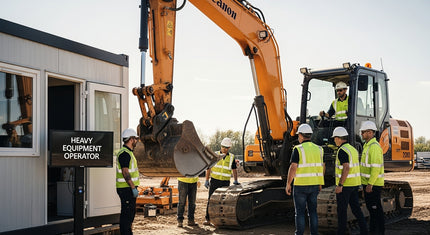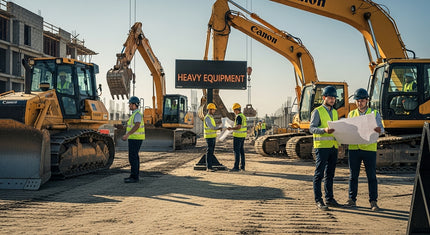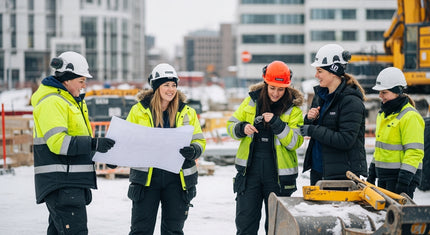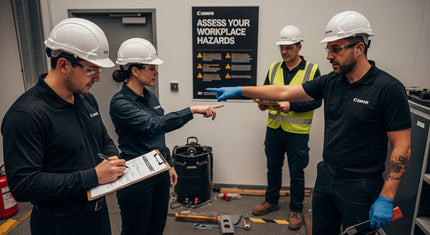Work clothing does a lot more than just cover your body. For blue collar professionals, it’s the invisible armor that faces everything from sharp metal edges to blazing sunshine. Here’s a wild fact. Workplace injuries cost industries billions every year according to the Bureau of Labor Statistics. So while you might think tough fabric is all that matters, the real secret is in the smart design and materials that keep workers comfortable, safe, and productive all day long.
Table of Contents
- What Defines Durable Work Clothing?
- Why Durable Clothing Matters For Blue Collar Workers
- How Materials Influence Performance And Comfort
- Key Styles And Features For Different Trades
- Real-World Applications And Benefits Of Rugged Apparel
Quick Summary
| Takeaway | Explanation |
|---|---|
| Prioritize high-quality materials | Selecting durable fabrics like ripstop nylon enhances clothing longevity and protection in tough working conditions. |
| Invest in ergonomic designs | Clothing with ergonomic features aids movement and reduces fatigue, boosting overall worker productivity. |
| Understand trade-specific needs | Each industry requires tailored workwear to address unique safety concerns and environmental challenges. |
| Enhanced safety improves performance | Durable clothing significantly reduces injury risks, promoting better performance by ensuring worker safety and comfort. |
| Long-term cost savings matter | Quality work apparel leads to fewer replacements and lower medical costs, making it a smart financial investment for professionals. |
What Defines Durable Work Clothing?
Durable work clothing represents more than just fabric and stitching – it’s a critical shield protecting workers across demanding environments. These specialized garments are engineered to withstand extreme conditions while providing comfort, functionality, and safety for blue collar professionals.
Material Strength and Resilience
The foundation of durable work clothing lies in its core materials. High-performance fabrics like heavy-duty cotton, ripstop nylon, and canvas are strategically selected for their superior resistance to wear and tear. According to OSHA guidelines, the right workwear isn’t just about durability, but also about protecting workers from potential workplace hazards.
Key characteristics of resilient work clothing include:
To help readers quickly compare the core material choices and their properties, here is a feature table highlighting the strengths of major fabrics used in durable work clothing.
| Fabric Type | Key Strengths | Common Uses |
|---|---|---|
| Heavy-Duty Cotton | Breathable, abrasion-resistant | General construction, carpentry |
| Ripstop Nylon | Tear-resistant, lightweight | Industrial, outdoor, utility work |
| Canvas | Extremely durable, withstands wear | Agriculture, manual labor, trades |
| Stretch Cotton Blend | Flexible, allows range of motion | Technical tasks, mechanics |
| Flame-Retardant | Heat/chemical resistance | Welding, electrical work |

- Reinforced stress points at seams and joints
- Abrasion-resistant fabric treatments
- Heavyweight textile construction
- Resistance to chemicals, oils, and environmental contaminants
Performance Features Beyond Basic Protection
True durability goes beyond basic material strength. Modern work clothing integrates advanced performance features that enhance worker productivity and safety.
These include moisture-wicking technologies, strategic ventilation, and ergonomic design elements that accommodate physical movement.
Professionals need clothing that can adapt to changing workplace demands. Whether working in construction, agriculture, or industrial settings, read more about specialized workwear options that offer comprehensive protection and comfort.
Ultimately, durable work clothing represents an investment in worker safety, performance, and long-term value. By selecting garments engineered with precision and purpose, blue collar workers can confidently tackle challenging environments while maintaining comfort and protection.
Why Durable Clothing Matters for Blue Collar Workers
Blue collar workers operate in environments where clothing isn’t just apparel – it’s a critical piece of professional equipment that directly impacts safety, performance, and career longevity. Understanding the deeper significance of durable work clothing reveals its profound importance beyond simple fabric protection.
Economic Impact of Quality Workwear
Investing in high-quality, durable work clothing represents a strategic financial decision for blue collar professionals. According to the Bureau of Labor Statistics, workplace injuries cost industries billions annually, with proper protective clothing playing a significant role in prevention.
Economic considerations of durable clothing include:
- Reduced replacement frequency
- Lower long-term personal equipment expenses
- Minimized potential medical costs from workplace incidents
- Enhanced job performance through comfort and protection
Safety and Professional Performance
Durable work clothing serves as a worker’s first line of defense against potential workplace hazards. Beyond physical protection, it communicates professionalism and commitment to safety standards. Learn more about specialized workwear options that support workers across diverse industries.
Quality workwear directly influences a professional’s ability to perform complex tasks safely and efficiently. Proper clothing can mean the difference between a standard workday and a potentially dangerous situation. From heat resistance to chemical protection, each garment element is engineered with worker safety in mind.
Ultimately, durable work clothing transcends being a mere wardrobe item – it’s an essential tool that empowers blue collar workers to perform at their best, stay protected, and maintain their professional integrity in challenging work environments.
How Materials Influence Performance and Comfort
Blue collar work clothing represents a sophisticated fusion of scientific engineering and practical design. Material selection goes far beyond aesthetic considerations, directly impacting worker performance, safety, and overall job effectiveness.
Fabric Technology and Performance Characteristics
According to textile engineering research, advanced fabric technologies transform work clothing from passive protection to active performance enhancement. Different materials offer unique advantages tailored to specific workplace environments.
Key performance fabric characteristics include:
- Moisture management capabilities
- Thermal regulation properties
- Chemical and abrasion resistance
- Lightweight durability
- Flexibility and range of motion
Ergonomic Material Design
Modern work clothing integrates intelligent material science that considers human physiology and movement patterns. Specialized textiles like stretch-infused cotton blends and engineered synthetic fabrics provide compression, breathability, and strategic support for physically demanding tasks.
Professionals require clothing that moves with their body, not against it. Check out our guide on specialized workwear solutions that demonstrate how advanced materials can transform workplace comfort and performance.
Beyond immediate protection, material selection influences long-term worker health, productivity, and professional confidence. By understanding the complex relationship between fabric technology and human performance, blue collar workers can make informed choices that elevate their entire professional experience.
Key Styles and Features for Different Trades
Work clothing isn’t a one-size-fits-all solution. Each trade demands unique apparel configurations that balance protection, functionality, and professional performance. Understanding these specialized requirements helps workers select the most effective workwear for their specific industry.
Trade-Specific Clothing Configurations
According to occupational safety research, different trades require nuanced clothing designs that address specific environmental and physical challenges. Workwear must adapt to the precise demands of each professional context.
Critical trade-specific clothing considerations include:
- Thermal protection for extreme temperature environments
- High-visibility requirements for construction and roadwork
- Chemical resistance for industrial and laboratory settings
- Flame-retardant materials for welding and electrical trades
- Puncture and cut-resistant fabrics for metalworking
Ergonomic Design Across Professions
Modern workwear transcends basic protection, integrating intelligent design principles that support human movement and job-specific tasks. Specialized features like reinforced knee panels for construction workers, breathable mesh panels for agricultural laborers, and stretch fabric zones for mechanics demonstrate how clothing can become a performance enhancement tool.
Explore our comprehensive guide to trades gear that showcases the latest innovations in professional workwear across different industries.
Ultimately, selecting the right workwear is about understanding the unique intersection between personal comfort, safety requirements, and professional performance.
This table summarizes specialized features and benefits of durable work clothing designed for different blue collar professions, making it easier to assess which features match specific job requirements.
| Profession/Trade | Essential Clothing Feature | Benefit Provided |
|---|---|---|
| Construction | Reinforced knee panels | Enhanced durability, comfort |
| Agriculture | Breathable mesh panels | Temperature control, reduced sweat |
| Industrial/Lab Work | Chemical-resistant fabric | Protection from hazardous exposure |
| Roadwork | High-visibility colors | Improved safety near vehicles |
| Welding/Electrical | Flame-retardant materials | Defense against burns and sparks |
| Metalworking | Cut-resistant textiles | Reduced risk of punctures/cuts |
| By recognizing how clothing design can be tailored to specific trade needs, workers can optimize their professional capabilities and protect themselves effectively. |

Real-World Applications and Benefits of Rugged Apparel
Rugged apparel represents more than protective clothing – it’s a critical professional tool that transforms workplace performance and worker safety. By integrating advanced materials and strategic design, modern workwear has become an essential component of professional success across numerous industries.
Performance Enhancement Through Advanced Design
According to OSHA safety guidelines, proper workwear significantly reduces workplace injury risks while improving overall worker efficiency. Rugged apparel goes beyond basic protection, offering multifunctional benefits that directly impact professional productivity.
Key performance advantages include:
- Increased mobility and reduced physical strain
- Enhanced workplace safety through protective features
- Temperature regulation in extreme environments
- Reduced fatigue during long work shifts
- Improved professional confidence and competence
Economic and Professional Impact
Rugged apparel represents a strategic investment for both workers and employers. Durable clothing reduces long-term equipment replacement costs and minimizes potential workplace injury expenses. Professionals wearing high-quality workwear demonstrate a commitment to safety, skill, and professional standards.
Check out our comprehensive workwear guide to explore how modern apparel technologies are revolutionizing workplace performance.
Ultimately, rugged apparel bridges the gap between personal protection and professional excellence. By understanding and selecting the right workwear, blue collar workers can optimize their performance, safety, and career potential in increasingly demanding work environments.
Elevate Your Everyday with Workwear Designed for Real Demands
Tired of clothing that wears out before the job is done? Real blue collar workers need gear that stands up to daily abuse, keeps you comfortable through long shifts, and backs your commitment to safety. The article showed how crucial quality materials and purpose-driven design are in preventing fatigue, reducing replacement costs, and boosting your on-the-job confidence. Don’t settle for apparel that lets you down when conditions get rough.

Ready to upgrade? Discover our exclusive Parody Blue Collar Hoodie Sweatshirts for unmatched comfort and humor on and off the clock. Or top off your rugged style with our Snapback and Dad Hats - Blue Collar Collection, built to last through every workday. Visit WorkwearComfort.com today and choose workwear trusted by hardworking professionals. The next level of durability and style is one click away. Don’t wait. Start outfitting yourself with gear that respects your work ethic now.
Frequently Asked Questions
What materials are commonly used in durable work clothing?
Durable work clothing is often made from high-performance fabrics like heavy-duty cotton, ripstop nylon, and canvas, which are selected for their resistance to wear and tear.
How do ergonomic designs enhance the performance of work clothing?
Ergonomic designs integrate features like stretch fabric zones and reinforced joints that support movement and reduce physical strain, allowing workers to perform tasks more efficiently and comfortably.
Why is moisture management important in work clothing?
Moisture management is crucial as it helps regulate body temperature and keeps workers dry, significantly improving comfort and reducing fatigue during long shifts in demanding environments.
What role does durable clothing play in workplace safety?
Durable clothing serves as a protective barrier against various workplace hazards, such as chemicals and extreme conditions, while also promoting professionalism and adherence to safety standards.
Recommended
- What Is Workwear? A 2025 Guide for Hardworking Professionals - WorkWear Comfort
- Understanding Workwear for Mechanics: Durability and Function – WorkWearComfort
- Understanding Blue Collar Worker Definition in Today’s World – WorkWearComfort
- Understanding Blue Collar Work and Its Impact – WorkWearComfort

